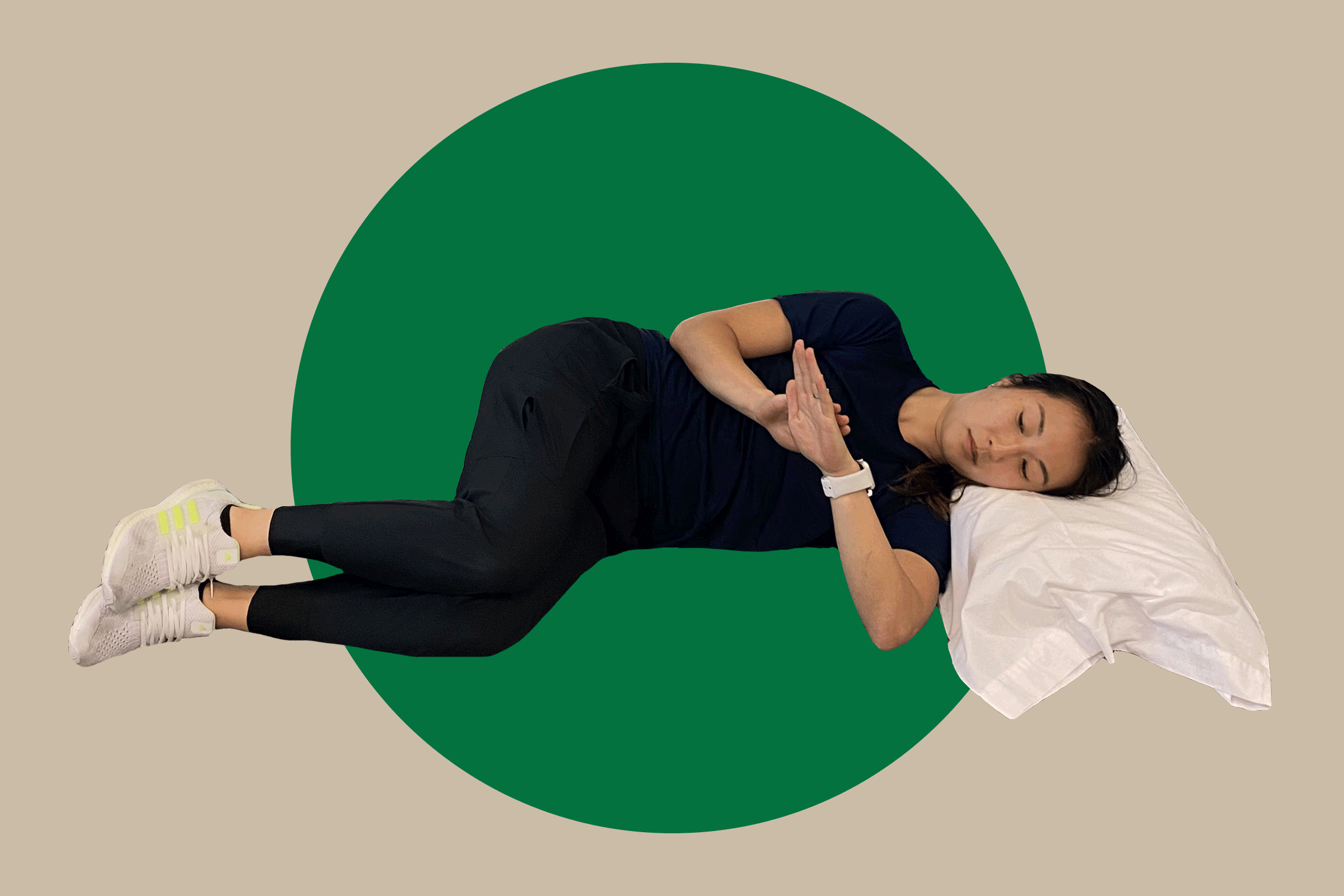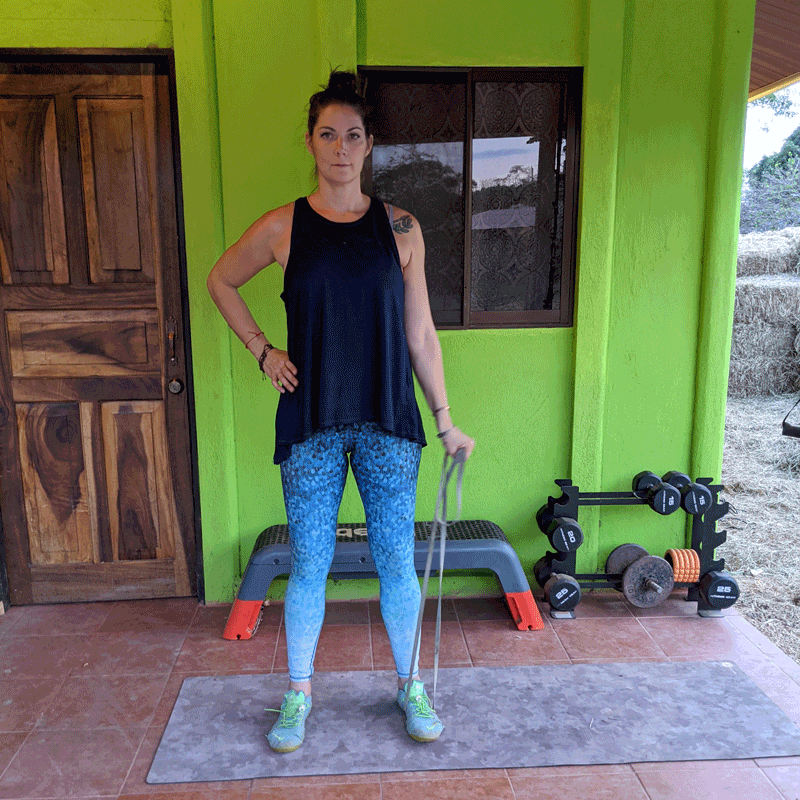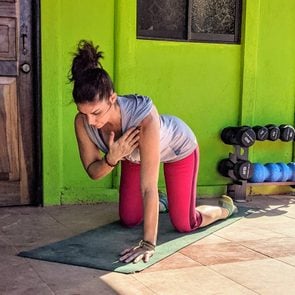How to Do a Sleeper Stretch for Better Shoulder Range of Motion
Updated: Jun. 30, 2021
Are your shoulders feeling tight? Improve your range of motion, increase flexibility, and prevent injury with the sleeper stretch.
What is the sleeper stretch?
If you sit at a computer most of the day, look down at your phone often, or generally stand with shoulders rounded forward, you probably have some tightness in your upper body. Doing a sleeper stretch daily (or every other day) can help.
This move, performed while lying on your side, stretches out the back of the shoulder—the posterior capsule, in doctor speak. It focuses on muscles that tend to get weak from a hunched position, says Houman Danesh, MD, director of integrative pain management at Mount Sinai hospital in New York City.
The goal of the stretch: increase your range of motion in the shoulder. This translates to better flexibility in your shoulders to help you perform daily tasks and prevent injury.
Benefits of the sleeper stretch for shoulders
Unlike the hip joint, which is a ball-and-socket joint and therefore more stable, the shoulder is meant to be mobile. It’s a free-floating joint, kept in place by the surrounding muscles, Dr. Danesh explains.
So you want those muscles working properly and feeling good. It’ll allow your shoulder to move in a healthy range of motion.
While many factors contribute to the mobility of the shoulder, good flexibility helps. That’s where the sleeper stretch comes in. It improves flexibility over time.
Because the sleeper stretch benefits the posterior capsule of the shoulder—rotator cuff muscles like the teres minor and infraspinatus, which help stabilize the back of the shoulder—it can benefit those with poor posture by increasing range of motion.
It can also help those with anterior shoulder pain (at the front of the shoulder) or those with aches from maintaining poor form while working out.
That can happen when you do moves like bench presses, push-ups, shoulder presses, pull-ups, dips, and front raises, says Melissa Garcia, a physical therapist and strength coach at Bespoke Treatments in Seattle.
“The shoulder is a complicated joint with lots of muscles that influence the way it moves in the socket,” she says. “If some of the supporting muscles are tight or even weak, it can often lead to pain and dysfunction.”
A healthy stretching routine, incorporating the sleeper stretch, helps you sidestep those aches and keep the shoulder working properly.
Who is the sleeper stretch best for?
Anyone can benefit from this stretch, but it’s particularly useful for desk workers or people with rounded shoulders, Dr. Danesh says. He also mentions that people with a previous shoulder injury that hasn’t been properly addressed may benefit from the move.
If you find it difficult to reach into the back seat of your car or grab something from an overhead cabinet, you might need more mobility in the shoulder, and this stretch can help.
Overall, it can relieve tightness and pain brought on by daily tasks or repetitive moves. The sleeper stretch is also ideal for athletes, like baseball and tennis players, who are more prone to shoulder tightness and generally want to improve range of motion.
In a small study of 66 men who played baseball, published in the Journal of Athletic Training, those who performed the sleeper stretch showed a better range of motion and an increase in internal shoulder rotation with the arm they used in baseball.
The researchers noted, however, that there were no changes with external shoulder rotation. Further research is warranted in a larger population to determine whether the sleeper stretch can help athletes and prevent injury.
(These are the everyday moves that hurt your body.)
Who shouldn’t do the sleeper stretch?
As with any exercise, if you experience pain, avoid this move and instead get your shoulder checked out by a doctor, says Dr. Danesh.
A rule of thumb: if you’re saying “ow” instead of “ooh” during this stretch, that’s probably a sign you should see someone.
And if you’re hypermobile, or double-jointed, you should avoid this stretch, both experts say.

How to do the sleeper stretch
Do this stretch once a day, holding for 20 to 30 seconds and repeating two to three times. If you’re super sore the next day, decrease to every other day, Garcia says.
To do it, lie on your right side on the floor, keeping your shoulders and hips stacked. Use a pillow to support your head, if possible.
Position your right arm out in front of you at a 90-degree angle at the shoulder. Bend your right elbow 90 degrees so your forearm is perpendicular to the floor.
Use your left arm to gently and slowly push your right palm toward the floor, until you feel resistance. Hold for 20 to 30 seconds.
Repeat on the other side.
A word about the sleeper stretch
You need a balance between flexibility and strength when it comes to the shoulder, according to Dr. Danesh. “You can’t have one over the other,” he says.
This means that in addition to stretches that improve range of motion, you also need strength moves to improve stability.
“If you’re already strong, then you want to focus on stretching,” he says. If you’re already flexible, you want to focus on strengthening.
No matter what, if you’re feeling pain (and not just tightness) it’s important to see a medical professional, like a physician, physical therapist, or pain management specialist.
Next, try these four stretches for your shoulder’s rotator cuff.



